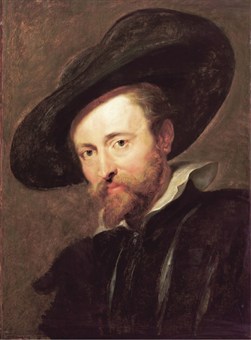Pieter Paul Rubens
 The son of a Flemish Calvinist who sought refuge in Cologne for religious reasons, Pieter Paul Rubens (1577-1640) lived in Italy from 1600 to 1608. Besides perfecting his art using examples taken from the great artists of the Renaissance, but also by Annibale Carracci and Caravaggio, Rubens entered the service of Vincenzo Gonzaga, the Duke of Mantua, for which he alternated work as a painter with diplomatic and political missions. The most famous of these took him to the court of King Philip III of Spain for eight months in 1603. He returned to the Netherlands where he devoted himself to an intense activity protected by the favour of the rulers Albert of Habsburg and Isabella. Continuing to alternate artistic with political-diplomatic activity (missions to Madrid and then London in the years 1628-1630), Rubens established himself as one of the greatest artists of his era. Among his works: the Equestrian Portrait of the Duke of Lerma, Samson and Delilah, Self-portrait with his wife, the Dead Christ, the 24 large canvases that make up the cycle of the allegories of the life of Maria de’ Medici Queen of France, the Triptych of San Ildefonsus.
The son of a Flemish Calvinist who sought refuge in Cologne for religious reasons, Pieter Paul Rubens (1577-1640) lived in Italy from 1600 to 1608. Besides perfecting his art using examples taken from the great artists of the Renaissance, but also by Annibale Carracci and Caravaggio, Rubens entered the service of Vincenzo Gonzaga, the Duke of Mantua, for which he alternated work as a painter with diplomatic and political missions. The most famous of these took him to the court of King Philip III of Spain for eight months in 1603. He returned to the Netherlands where he devoted himself to an intense activity protected by the favour of the rulers Albert of Habsburg and Isabella. Continuing to alternate artistic with political-diplomatic activity (missions to Madrid and then London in the years 1628-1630), Rubens established himself as one of the greatest artists of his era. Among his works: the Equestrian Portrait of the Duke of Lerma, Samson and Delilah, Self-portrait with his wife, the Dead Christ, the 24 large canvases that make up the cycle of the allegories of the life of Maria de’ Medici Queen of France, the Triptych of San Ildefonsus.
